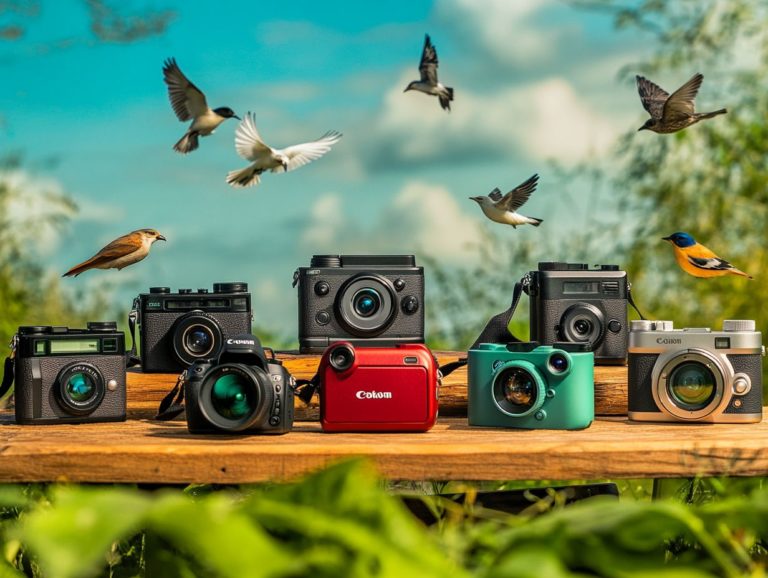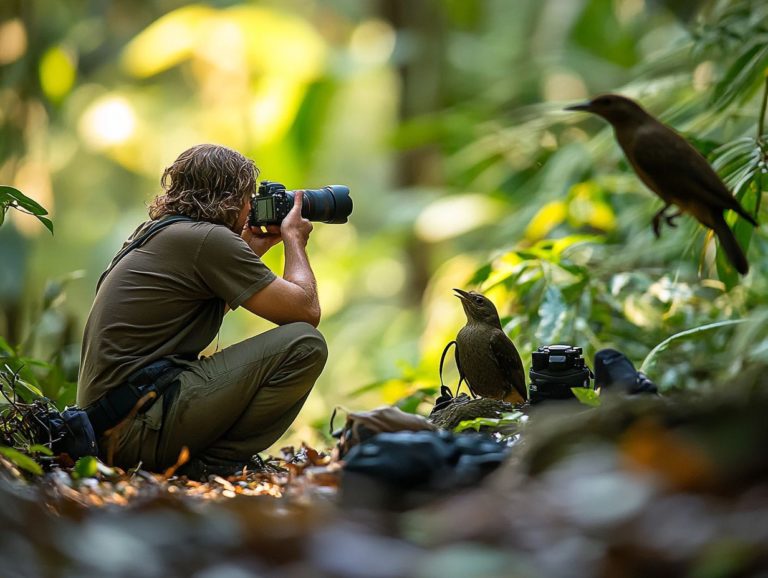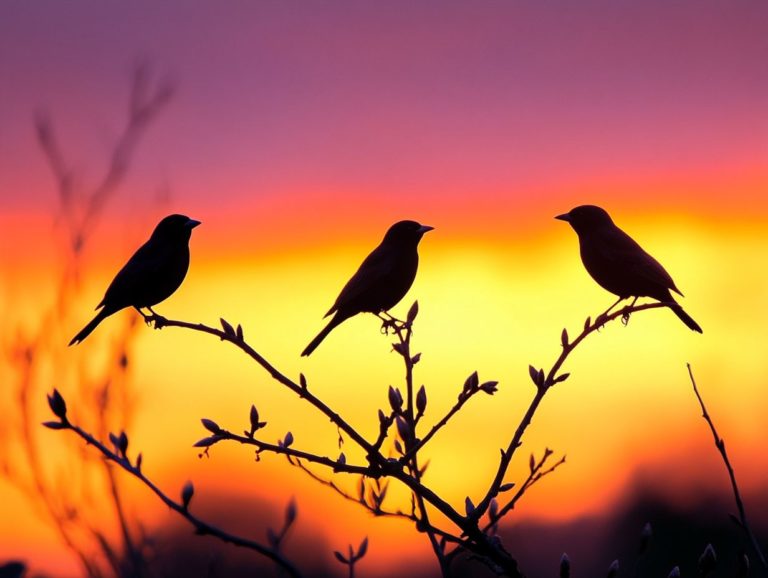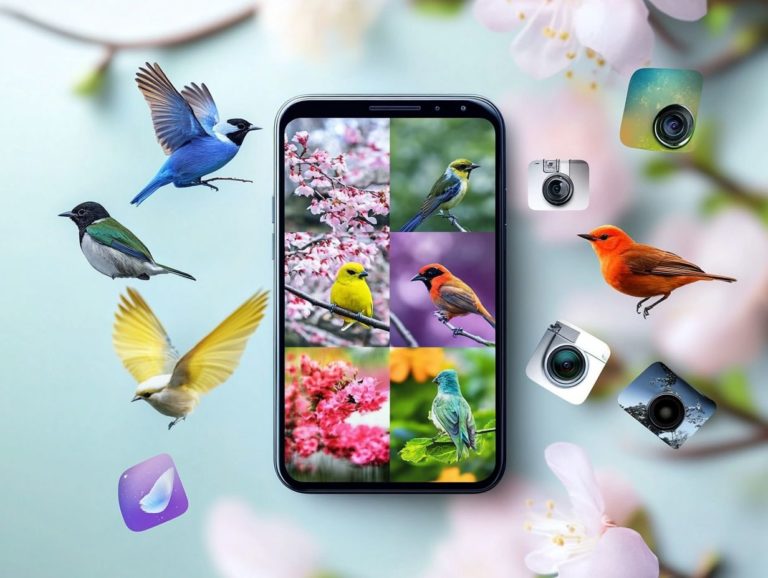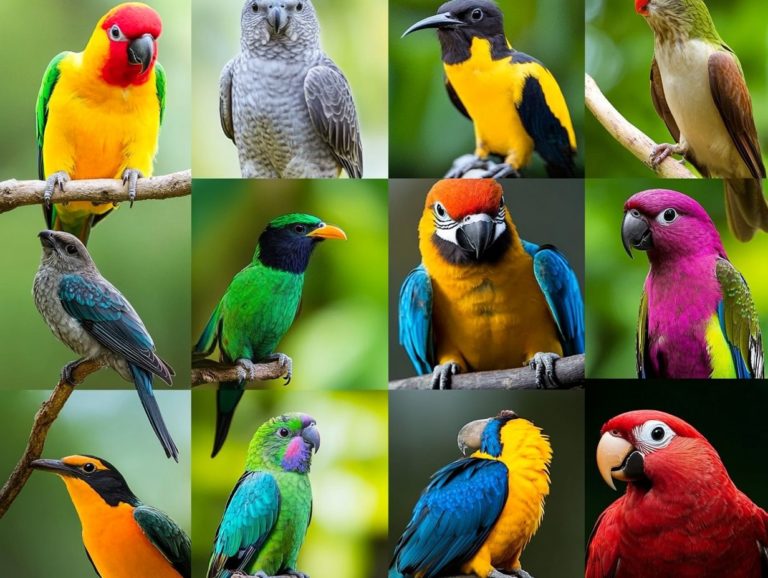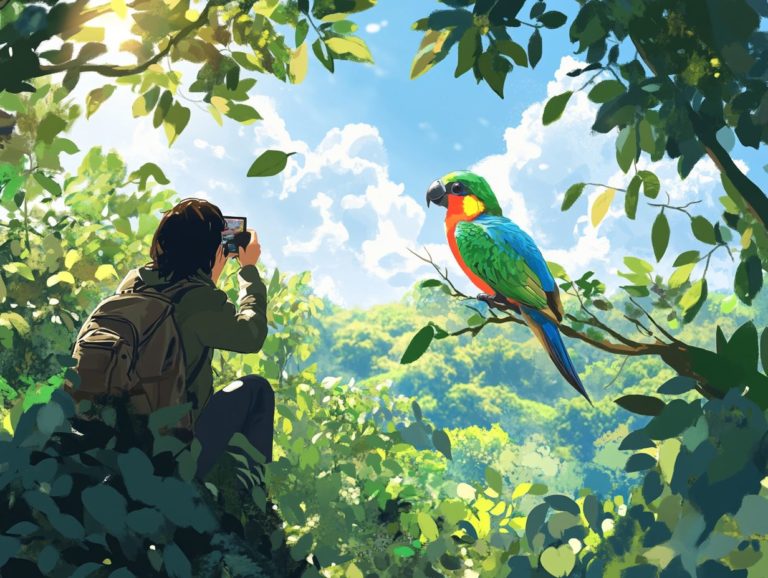How to Photograph Migratory Birds
Migratory birds captivate nature enthusiasts and photographers alike, showcasing the stunning diversity of our planet’s avian life. Renowned species such as the golden eagle and the lilac-breasted roller are just a few examples of these extraordinary creatures.
This guide will equip you with essentials for photographing migratory birds. You will explore different types of migratory birds, uncover the best locations to capture breathtaking moments, and identify the necessary photography gear for success.
Discover techniques to elevate your shots, navigate challenges like unpredictable weather, and gain valuable tips for post-processing and sharing your work.
Embark on this journey to enhance your bird photography skills and embrace the art of capturing nature s wonders!
Contents
- Key Takeaways:
- Understanding Migratory Birds
- Best Locations for Photographing Migratory Birds
- Essential Photography Equipment
- Techniques for Photographing Migratory Birds
- Dealing with Challenges and Obstacles
- Post-Processing and Sharing Your Wildlife Photography
- Frequently Asked Questions
- What are some tips for photographing migratory birds?
- What camera settings should I use to capture migratory birds?
- Is it necessary to use a tripod when photographing migratory birds?
- What is the best time of day to photograph migratory birds?
- How can I capture birds in flight during migration?
- What ethical considerations should I keep in mind when photographing migratory birds?
Key Takeaways:
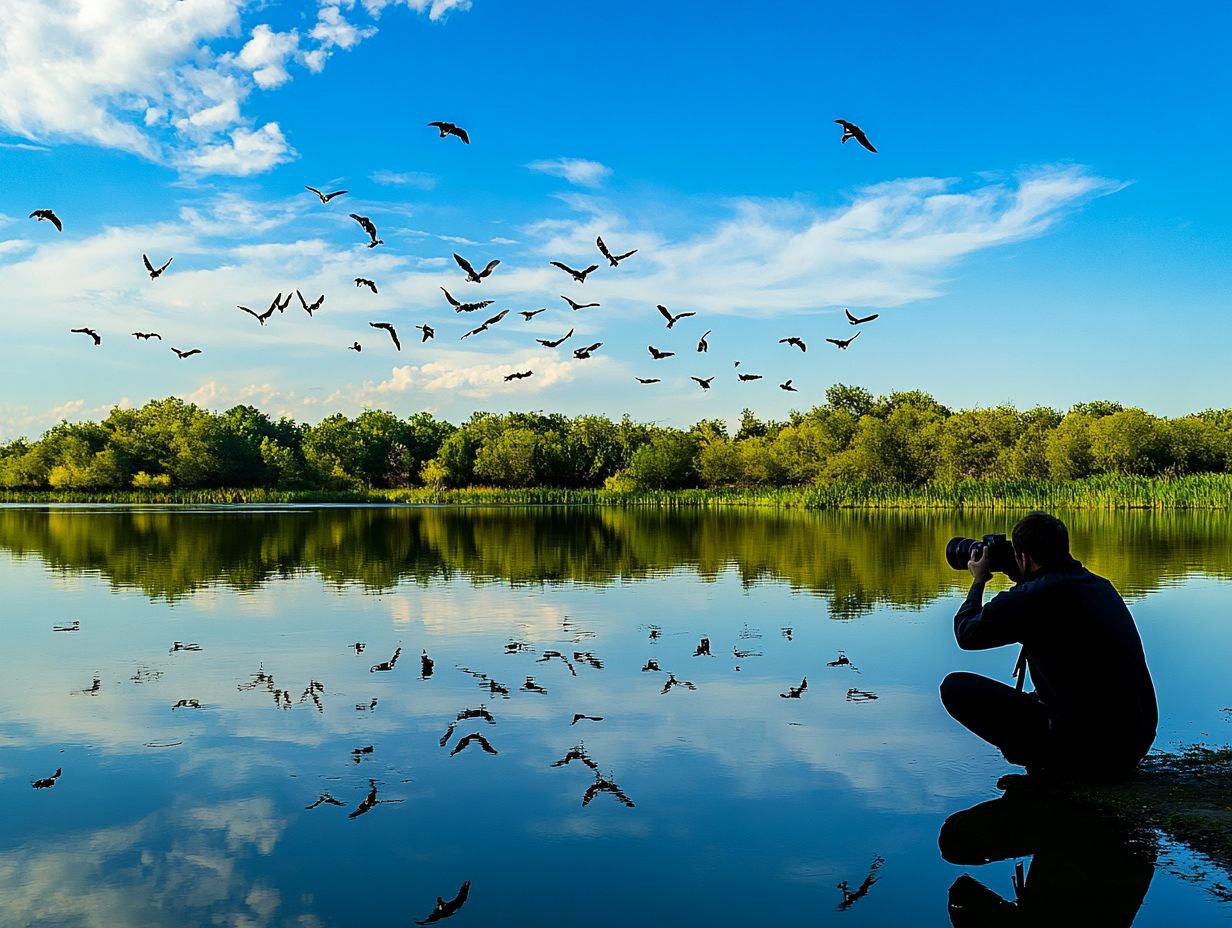
- Understand the types of migratory birds and their behavior to capture them in their natural habitat.
- Research and visit top destinations for bird migration to increase your chances of stunning photos.
- Invest in recommended camera equipment, such as telephoto lenses and tripods, for crisp and clear shots.
Understanding Migratory Birds
Migratory birds are captivating creatures that embark on remarkable journeys each year, showcasing astonishing adaptations and behaviors. These journeys often span entire continents, with iconic species like the golden eagle and the lilac-breasted roller leading the way.
To appreciate these avian travelers, delve into their world. This knowledge can enhance your nature photography and birding techniques. Additionally, learning how to use natural light in bird photography will better equip you to capture stunning images while gaining insight into the challenges these birds face.
Types of Migratory Birds
Migratory birds come in various captivating types. Some breed in North America and winter in Central America, while others embark on daring ocean crossings.
Take, for instance, the stunning Monarch butterfly, renowned for its incredible migration from Canada to Mexico. Then there’s the Arctic Tern, a true champion of travel, boasting the longest migration of any bird as it journeys from the Arctic to the Antarctic and back each year.
You might also notice the American Robin, a familiar and beloved presence in many North American gardens. It migrates primarily in search of food, journeying to warmer regions during winter.
These remarkable species demonstrate incredible flight endurance and exhibit unique adaptations, like the Arctic Tern s specialized feeding habits, enabling it to thrive in diverse environments along its migration route.
Best Locations for Photographing Migratory Birds
To capture breathtaking images of migratory birds, journey to the finest locations that serve as true birding hotspots. Picture the stunning landscapes of Africa, particularly in Tanzania and Kenya, alongside renowned parks like Kruger National Park and Manu National Park.
Each of these destinations presents unique opportunities and challenges for photography, making it crucial to plan your visits during peak migration seasons.
Top Destinations for Bird Migration
Explore iconic locations like Cape May and Grand Isle, renowned for their vibrant avian life during migration seasons.
These exceptional sites serve as crucial waypoints for numerous species on lengthy journeys, often in search of warmer climates or abundant feeding grounds. Visitors are treated to spectacular sights, especially during the peak migration months of spring and fall.
In Cape May, watch hawks soaring majestically through the skies, while the marshes of Grand Isle come alive with the bustling presence of herons and shorebirds.
Each birding hotspot offers unique opportunities to witness not only the migration but also the captivating behaviors of these remarkable creatures in their natural habitats.
Essential Photography Equipment
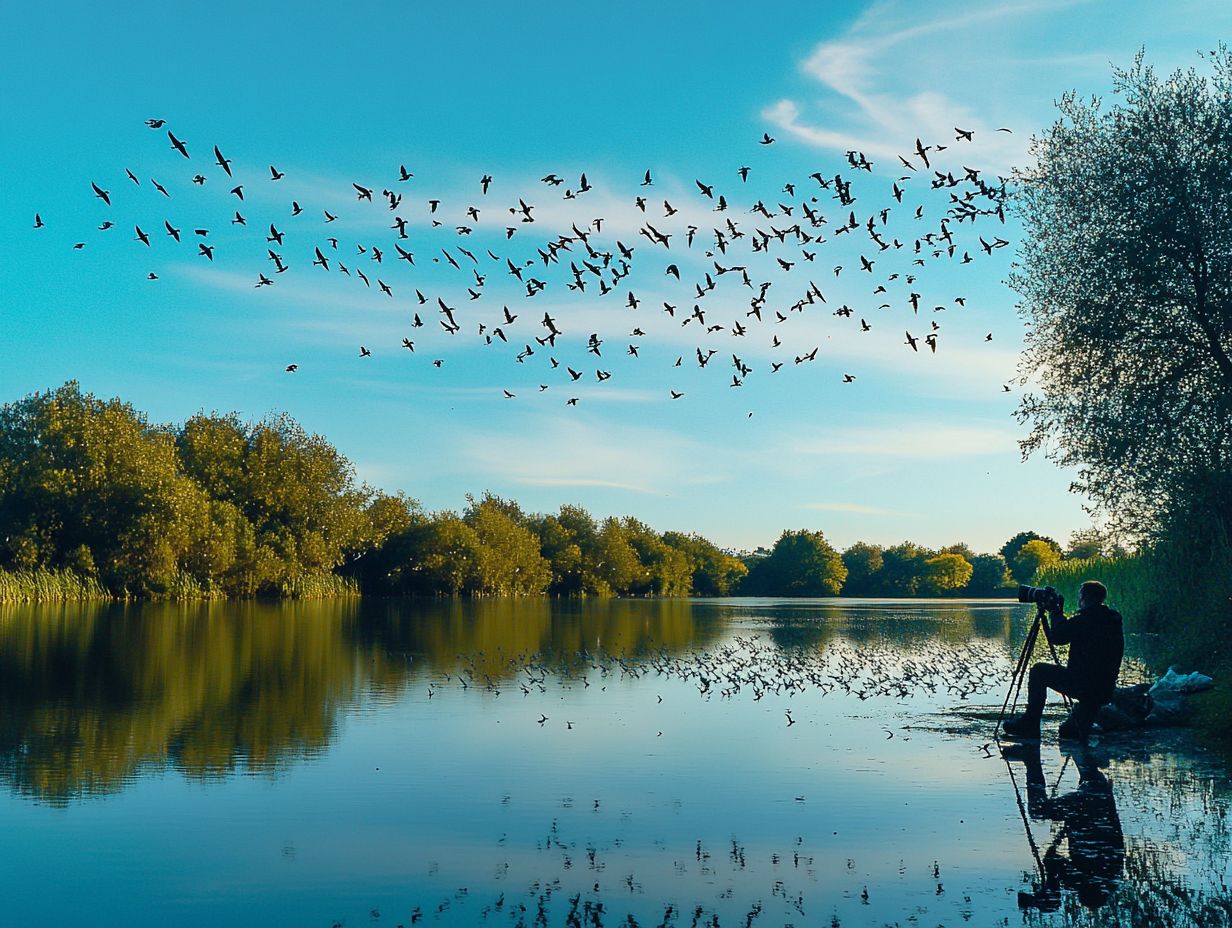
To capture stunning images of migratory birds, selecting the right photography equipment is paramount. For those interested in enhancing their skills, exploring techniques for nighttime bird photography can be particularly beneficial. Opt for a high-performance camera, such as the Nikon D850 or Canon EOS-1D, paired with an appropriate lens to truly elevate your photography game.
Focus on key features like continuous autofocus, exposure compensation, Auto ISO, and image stabilization. These features are essential for ensuring your images of birds in flight are sharp and vibrant.
Recommended Gear for Capturing Birds
When you re poised to capture breathtaking bird photography, the choice of gear becomes paramount. Brands like Nikon and Canon stand out for their exceptional performance and quality.
Selecting the right lens is essential to your success. Consider options like the Nikon AF-S NIKKOR 200-500mm f/5.6E and Canon EF 100-400mm f/4.5-5.6L IS II. These lenses offer superb image stabilization and remarkable sharpness.
Their versatility allows you to maintain distance while capturing incredible detail, vital for those elusive shots. You can use devices that increase the zoom capabilities of your lens, known as teleconverters, to further enhance your focal length and reach distant subjects without compromising image quality.
Don t miss out! Accessories like sturdy tripods and gimbals can make all the difference. They provide the stability and fluid movement needed during those fleeting moments when a bird takes flight, ensuring that every click becomes a masterpiece.
Techniques for Photographing Migratory Birds
Mastering the art of photographing migratory birds is crucial for anyone aiming to elevate their skills in wildlife photography. By employing effective birding techniques such as fine-tuning your shutter speed and utilizing continuous autofocus, you can significantly enhance the quality of your images. Additionally, consider exploring tips for photographing birds in bad weather to improve your shots in challenging conditions.
Engaging in photography lessons centered around these techniques offers invaluable insights for both beginners and seasoned photographers.
Tips for Getting the Perfect Shot
Capturing the perfect shot of a migratory bird demands meticulous planning and execution. Here are tips for photographing rare bird species to enhance your photographic success.
Understanding your camera settings is essential. For instance, adjusting the exposure compensation can dramatically change how light is rendered, especially in shifting lighting conditions. Experiment with different shutter speeds to see what captures the motion best, ensuring every detail of the bird in flight remains crisp and clear.
Don t overlook the power of natural light during the golden hours shortly after sunrise or before sunset. This can elevate your images, casting a warm, enchanting glow on your subjects. Start using these techniques now, and watch your wildlife shots soar!
Dealing with Challenges and Obstacles
When you venture into wildlife photography, especially with migratory birds, you ll likely face a range of challenges and obstacles, including the unpredictability of weather and lighting conditions.
Overcoming Weather and Lighting Conditions
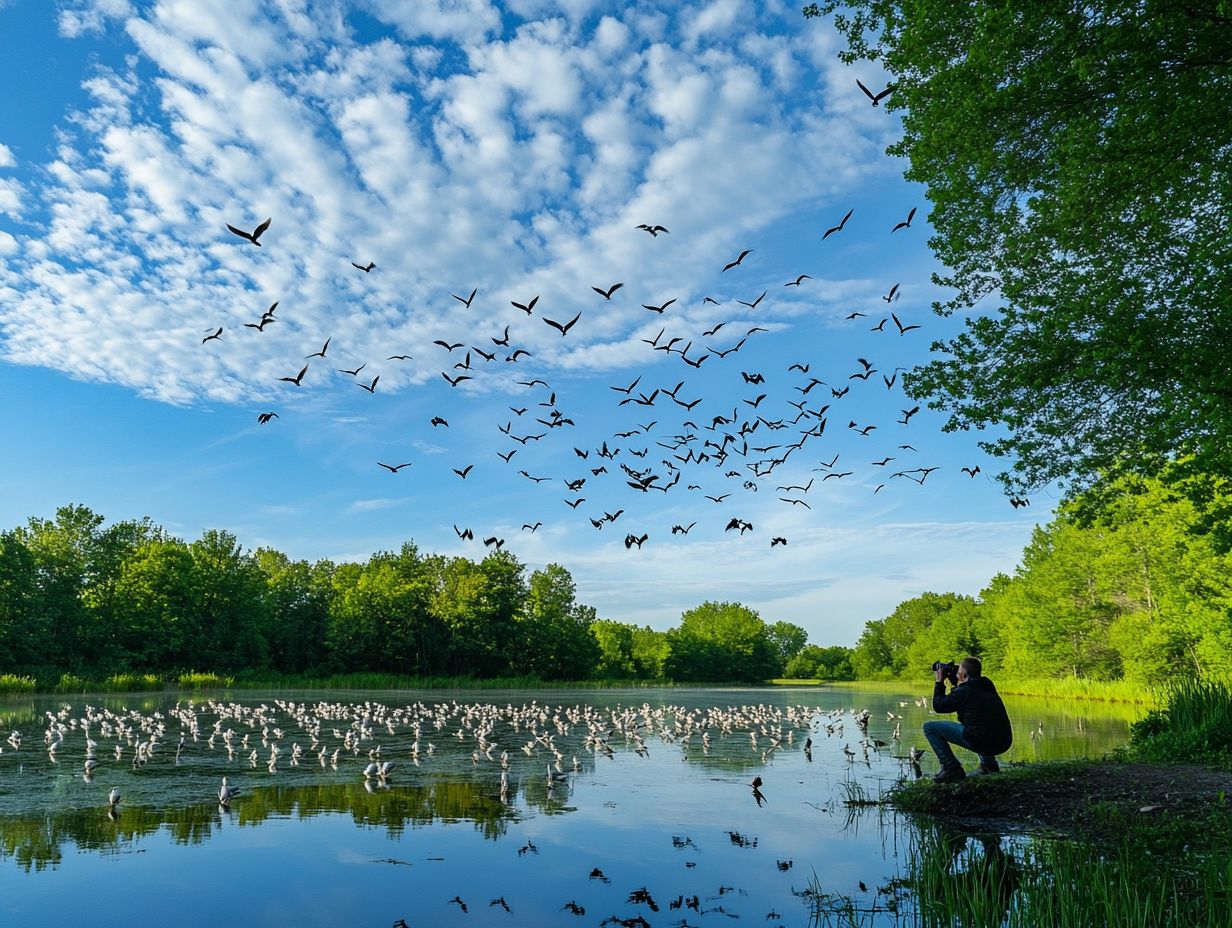
Adapting to the ever-changing weather and lighting conditions is essential for your success in wildlife photography. Mastering your camera settings will help you fully leverage the natural light and weather variations around you.
For instance, on those overcast days, increasing your ISO will help you maintain a well-exposed image while ensuring your shutter speed is fast enough to freeze the action. When the sun shines brightly, a quicker shutter speed will prevent overexposure as birds soar through the sky.
Don’t overlook the potential of manual white balance settings. Experimenting with them can significantly enhance color accuracy, ensuring the vibrant plumage of the birds truly stands out. Incorporate polarizing filters for reducing glare and boosting contrast, allowing for a clearer view of these magnificent creatures in their natural habitats.
In conclusion, the right gear, techniques, and adaptability are fundamental in wildlife photography. Equip yourself with the knowledge and tools, including how to use binoculars for bird migration watching, to capture stunning images of migratory birds.
Respecting the Birds and their Environment
Respecting migratory birds and their environments is essential in wildlife photography. It helps maintain the delicate balance of nature. To enhance your experience, learn how to take photos while bird watching and always be aware of the potential impact your presence can have on these birds, especially during critical periods like nesting and feeding.
To capture stunning images without disrupting their natural behaviors, consider strategies such as observing from a distance and using long lenses. For more tips, check out this guide on how to safely photograph birds in the wild. It’s crucial to be knowledgeable about the specific migratory patterns and habitats of the species you’re photographing.
By prioritizing the well-being of these creatures and fostering awareness of conservation efforts, you can play a vital role in safeguarding the ecosystems that support migratory avian life.
Post-Processing and Sharing Your Wildlife Photography
Post-processing is a crucial phase in wildlife photography that allows you to improve your images and show your work beautifully. Using software tools like Topaz DeNoise AI and Sharpen AI can enhance the quality of your photos, transforming them into striking visuals perfect for showcasing in photography workshops and on social media platforms.
Editing and Enhancing Your Wildlife Photography Images
Editing and enhancing your wildlife photography is essential for achieving professional-quality results that genuinely capture the breathtaking beauty of migratory birds.
By utilizing various editing techniques and software options, you can significantly elevate the overall impact of your shots. Programs like Adobe Lightroom and Photoshop provide advanced tools for color correction, sharpness adjustment, and noise reduction, allowing you to refine the details that showcase the vibrant plumage and intricate behaviors of these captivating creatures.
Incorporating techniques such as cropping for improved composition or applying graduated filters can effectively guide the viewer’s eye to specific focal points. As you edit, maintain a subtle touch this ensures authenticity while enhancing the natural allure of each feathered subject.
Sharing Your Work and Connecting with Other Photographers
Sharing your wildlife photography work is crucial for connecting with fellow photographers and immersing yourself in the vibrant community of birding enthusiasts.
Use platforms like Instagram and Flickr to showcase your stunning images to a broader audience while receiving valuable feedback from your peers. Participating in photography workshops sharpens your technical skills and cultivates relationships with like-minded individuals who share your passion for capturing nature’s beauty.
Engaging with these communities provides appreciation for your work and insights and encouragement that can elevate your photographic journey. Using hashtags related to wildlife and birding further enhances your visibility, making it easier for enthusiasts to discover your captivating images and connect with you as a creator.
Frequently Asked Questions
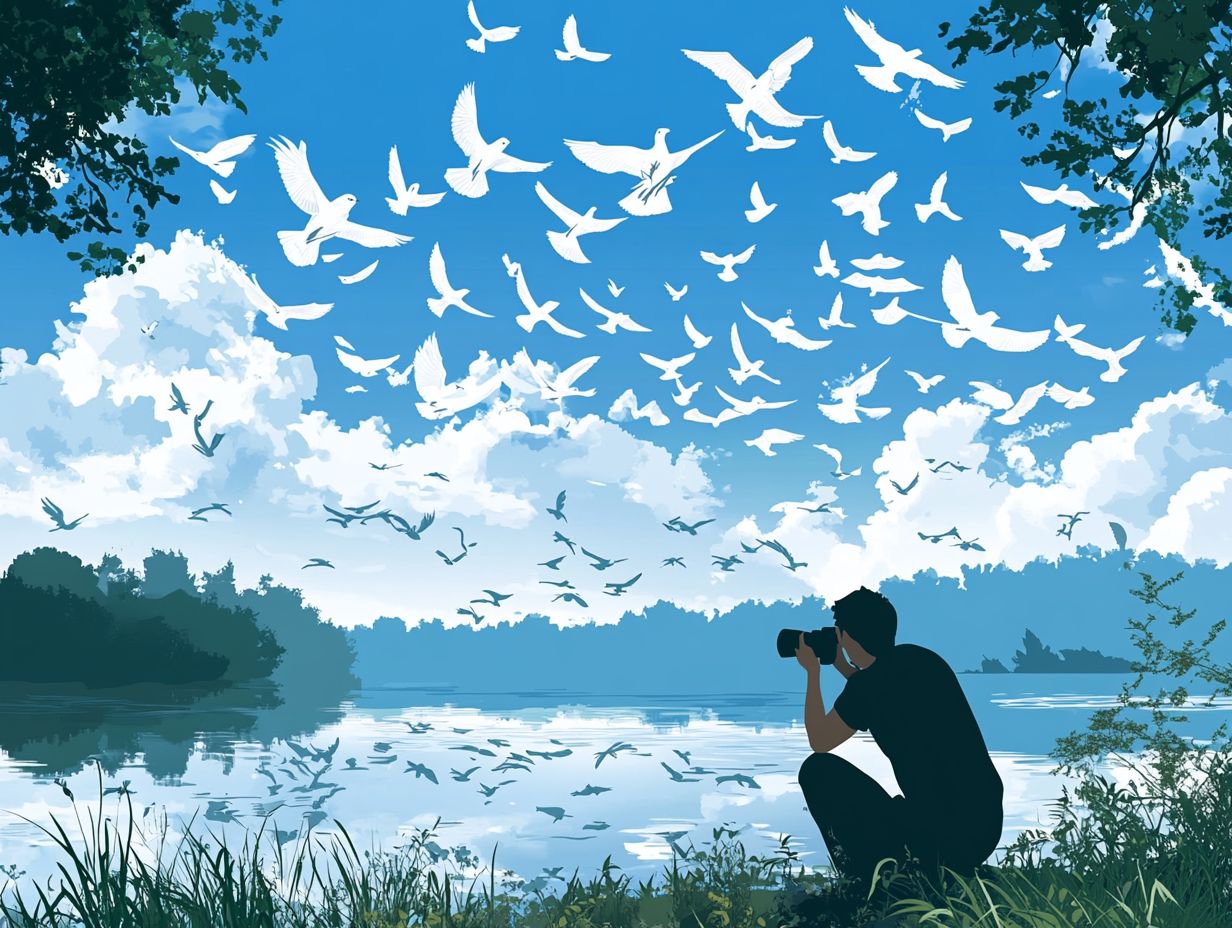
What are some tips for photographing migratory birds?
- Choose the right location: Research the best spots for migratory bird sightings.
- Use a telephoto lens: A lens that lets you take close-up photos from far away.
- Opt for fast shutter speed: Freeze the action with a quick shutter.
- Be patient: Be patient wait for that perfect moment to capture the action!
- Use camouflage: Blend in with your surroundings.
- Pay attention to the light: Good lighting makes a great photo.
What camera settings should I use to capture migratory birds?
Get ready to capture stunning shots by using a fast shutter speed! Aim for a shutter speed of at least 1/1000th of a second and set your ISO to 400 or higher. Adjust these settings based on the lighting conditions and the speed of the birds.
Is it necessary to use a tripod when photographing migratory birds?
While using a tripod can be helpful, it’s not always necessary. If you’re shooting from a boat or a moving vehicle, a tripod may not be practical.
Using a monopod also provides support when a tripod isn’t practical. You can also rest your camera on a stable surface for a steady shot.
What is the best time of day to photograph migratory birds?
The best time to photograph migratory birds is during the early morning or late evening hours. This is when the light is softer and warmer, creating a more pleasing effect in your photographs. To enhance your experience, consider preparing for a bird photography outing.
Additionally, birds are more active and easier to spot during these times.
How can I capture birds in flight during migration?
Capturing birds in flight during migration can be challenging, but here are some tips to help:
- Use a fast shutter speed and continuous shooting mode.
- Keep your camera focused on the bird and anticipate its movements.
- Try to capture the birds against a clear, uncluttered background.
- Experiment with different camera angles and compositions.
- Practice makes perfect, so keep trying and you’ll eventually capture the perfect shot.
What ethical considerations should I keep in mind when photographing migratory birds?
Always put the birds and their habitats first when taking photos. Here are some ethical guidelines to follow:
- Do not disturb or harm the birds in any way.
- Do not enter restricted areas or break any rules or regulations.
- Avoid using flash photography, as it can startle or disorient the birds.
- Respect the environment; do not leave any trash or damage behind.
- Educate yourself and others on the importance of conservation and responsible tourism.
Now that you’re equipped with these tips, be sure to learn how to stay hidden while bird photography, grab your camera, and start capturing those breathtaking moments of migratory birds!

